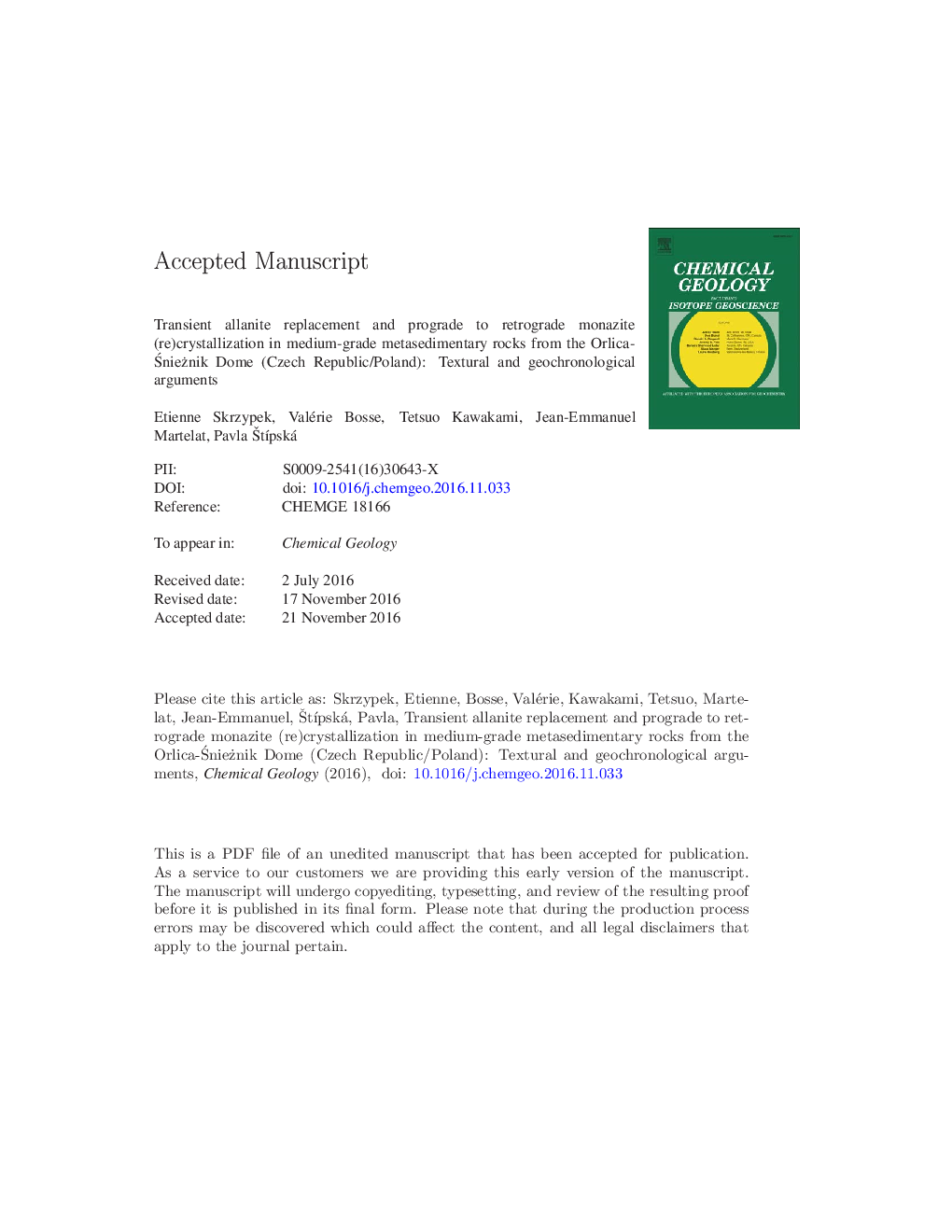| کد مقاله | کد نشریه | سال انتشار | مقاله انگلیسی | نسخه تمام متن |
|---|---|---|---|---|
| 5782778 | 1637525 | 2017 | 49 صفحه PDF | دانلود رایگان |
عنوان انگلیسی مقاله ISI
Transient allanite replacement and prograde to retrograde monazite (re)crystallization in medium-grade metasedimentary rocks from the Orlica-Ånieżnik Dome (Czech Republic/Poland): Textural and geochronological arguments
دانلود مقاله + سفارش ترجمه
دانلود مقاله ISI انگلیسی
رایگان برای ایرانیان
کلمات کلیدی
موضوعات مرتبط
مهندسی و علوم پایه
علوم زمین و سیارات
ژئوشیمی و پترولوژی
پیش نمایش صفحه اول مقاله

چکیده انگلیسی
We use textural and geochronological arguments to constrain monazite petrogenesis and the age of metamorphic events in medium-grade metasedimentary rocks from the European Variscan Belt (Orlica-Ånieżnik Dome, Czech Republic/Poland). The relationships between monazite, allanite and other major and accessory phases are characterized for staurolite-, sillimanite- and kyanite-grade, garnet-bearing mica schist samples. Garnet porphyroblasts with prograde compositional zoning include allanite in the core and monazite at the rim. Allanite is virtually absent from the matrix; it shows replacement textures involving a cluster of Th ± U ± Y-rich silicates or phosphates. Monazite, with frequent micro-cracks or trimmed grain boundaries, abounds in the mica-rich matrix; it occurs as lone grains close to partially resorbed garnet, apatite or staurolite, and as subhedral and compositionally zoned aggregates associated with allanite and xenotime. Electron microprobe analyses of monazite define Pb vs. Th* isochrons (ages = 363-343 Ma) with positive intercepts (Pb0 = 40-120 ppm) which suggest the presence of initial Pb and age overestimation. Isotopic analyses obtained by laser ablation coupled with mass spectrometry confirm the minor presence of initial Pb which leads to variable discordance in the 206Pb/238U-207Pb/235U system. Conversely, the 206Pb/238U-208Pb/232Th system is not visibly affected; analyses are concordant and 208Pb/232Th ages range from 358 to 299 Ma (± 7-8 Ma) regardless of monazite texture or composition. They define a main group at 330-310 Ma, with few older outliers. All observations suggest that a first monazite generation (MnzI) formed via allanite breakdown at prograde to peak P-T conditions (5-7 kbar/575-640 °C). A comparison with previous geochronological results reveals that the age of this prograde reaction is, however, preserved by only few domains yielding 360-340 Ma. Instead, our results emphasize the importance of retrograde processes which built the dominant age population of 330-310 Ma. The latter ages are ascribed to a combination of (1) transient monazite growth after allanite and controlled by P availability, (2) variable recrystallization/replacement of older monazite grains, and (3) minor monazite neoformation due to the resorption of garnet or apatite. The young monazite grains or domains (MnzII) mostly formed during fluid influx and chloritization; they constrain the end of the orogenic history when mid-crustal rocks were exhumed and re-hydrated at temperatures below ~ 300 °C.
ناشر
Database: Elsevier - ScienceDirect (ساینس دایرکت)
Journal: Chemical Geology - Volume 449, 20 January 2017, Pages 41-57
Journal: Chemical Geology - Volume 449, 20 January 2017, Pages 41-57
نویسندگان
Etienne Skrzypek, Valérie Bosse, Tetsuo Kawakami, Jean-Emmanuel Martelat, Pavla Å tÃpská,